The previous Porsche Boxster, barely old enough for the grave, was notoriously great.
The first had been great enough to save Porsche; the outgoing one was great enough for us to briefly scrap the top five list in which it appeared, so distant was it from whichever also-ran we considered installing in second place.I still remember driving it at launch in manual 2.7-litre format and, at high revs in third gear, pulling a face not usually associated with being outdoors or even sitting up.
Read our full review of the Porsche 718 Boxster here
On a sunny day, on an empty road, it could be truly intoxicating by providing the prerequisite qualities of sound, speed, size, breeze, handling, feedback and soul in uncannily precise measure. So palpable was the effect that you needed no expert ability or bravery to access it. Like a Caterham Seven or a Mazda MX-5, it indulged layman and connoisseur alike. It had it all going on.
It’s not easy, then, to take an immediately sympathetic view of its replacement, the newly titled 718 Boxster, a car obliged to tamper with its predecessor’s impeccable proportions with the introduction of an all-new turbocharged fourpot engine. Despite retaining horizontally opposed cylinders and extracting an impressive 345bhp from them in 2.5-litre S format (a 34bhp increase over its predecessor’s 3.4-litre flat six), early word suggests that the model’s time spent in solo orbit through our ratings has come to an end. At the very least, it’s time to return the Boxster to earth and consider its new identity alongside the current horde of next-best options – many of which have already perfected the art of presenting a smaller-capacity four-pot engine as ideal, rather than obligatory.
Foremost among them in that regard must be the Lotus Elise, a car that has never laboured under the weighty reputation of a big motor. It hasn’t needed to. The first generation was half the weight of a hatchback, so the traditional power source of a hatchback served it well. Since then, it has become heavier (to help you survive a shunt), but the output of its Toyota-supplied engines has swelled, too, keeping the balance of its own stellar reputation generally on song.
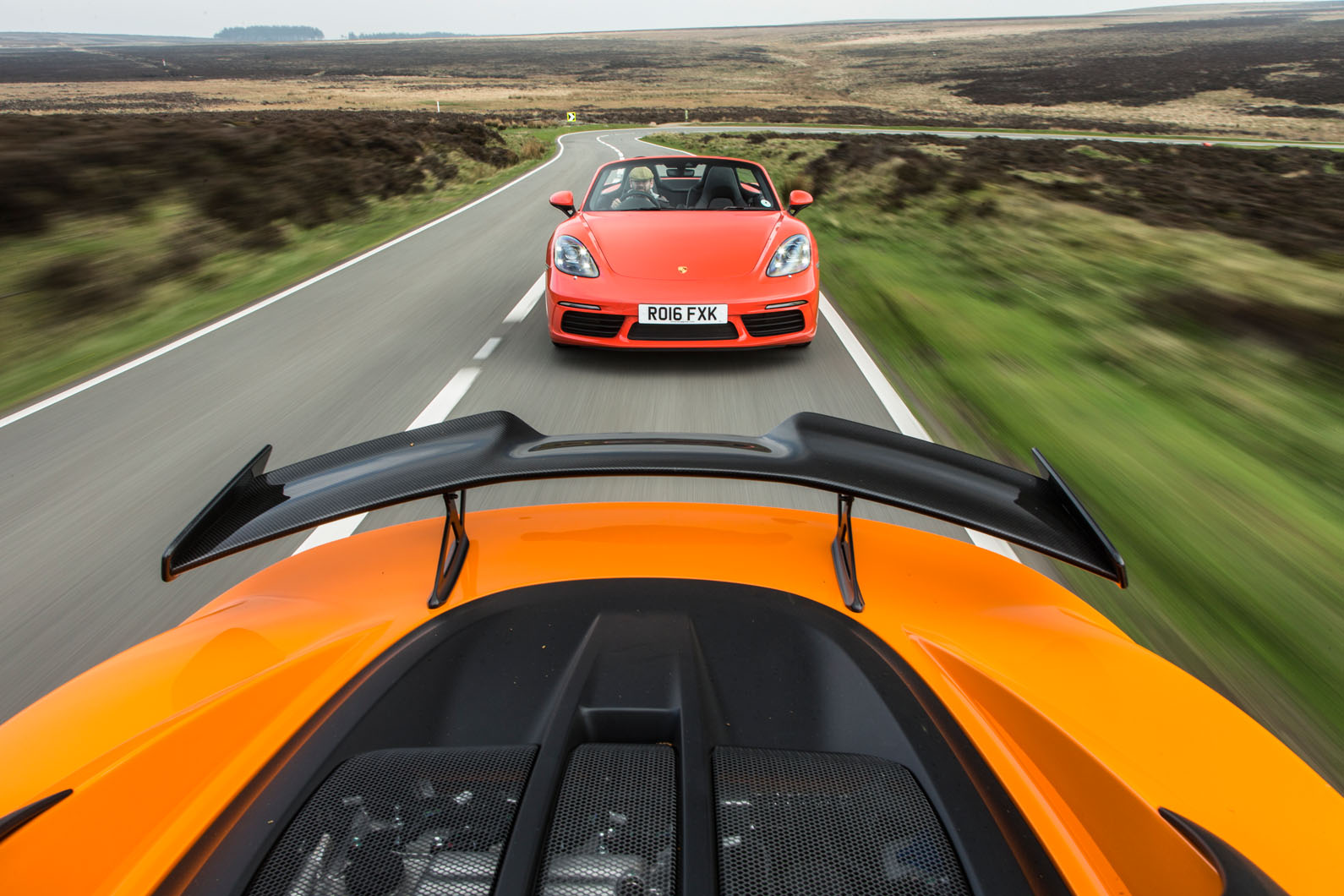
Which brings us neatly to the new Cup 250, a limited-edition Elise that uses a new, higher-output version of the supercharged 1.8 to provide the roadster with 243bhp – the sort of power previously preserved for the more belligerent hard-top Exige. Giving up 102bhp to the Boxster sounds substantial, but let’s not forget that the Porsche weighs around 400kg more than Norfolk’s finest, which has shed 21kg as part of the dialled-up Cup agenda.
Read more about the 2020 Lotus Elise
In power-to-weight ratio, then, they’re on the same page. Ditto the claimed 0-62mph times of 4.3sec for the Lotus and 4.6sec for the Porsche. Even the starting price – £45,600 Elise, £50,695 Boxster S – puts them in the same ballpark. Both four-pots are carried between the axles and both drive through six-speed manual gearboxes. Both are two-seaters.
The differences are more obvious. The 718, in the best tradition of its maker, has changed its name but not its stripes. A redesign has it sliding into middle age with Gwyneth Paltrow-style studiousness, getting no more handsome, just leaner and vaguely more masculine. The Elise is ridiculously twee in comparison (there’s no need to stand back to take it all in) but also supercar pretty. While the Cup’s rear diffuser hangs from the back end like a wispy beard sprouting from a pirate’s chin, the introduction of the colossal spoiler above it gives the Elise the visual mettle the Boxster arguably lacks.
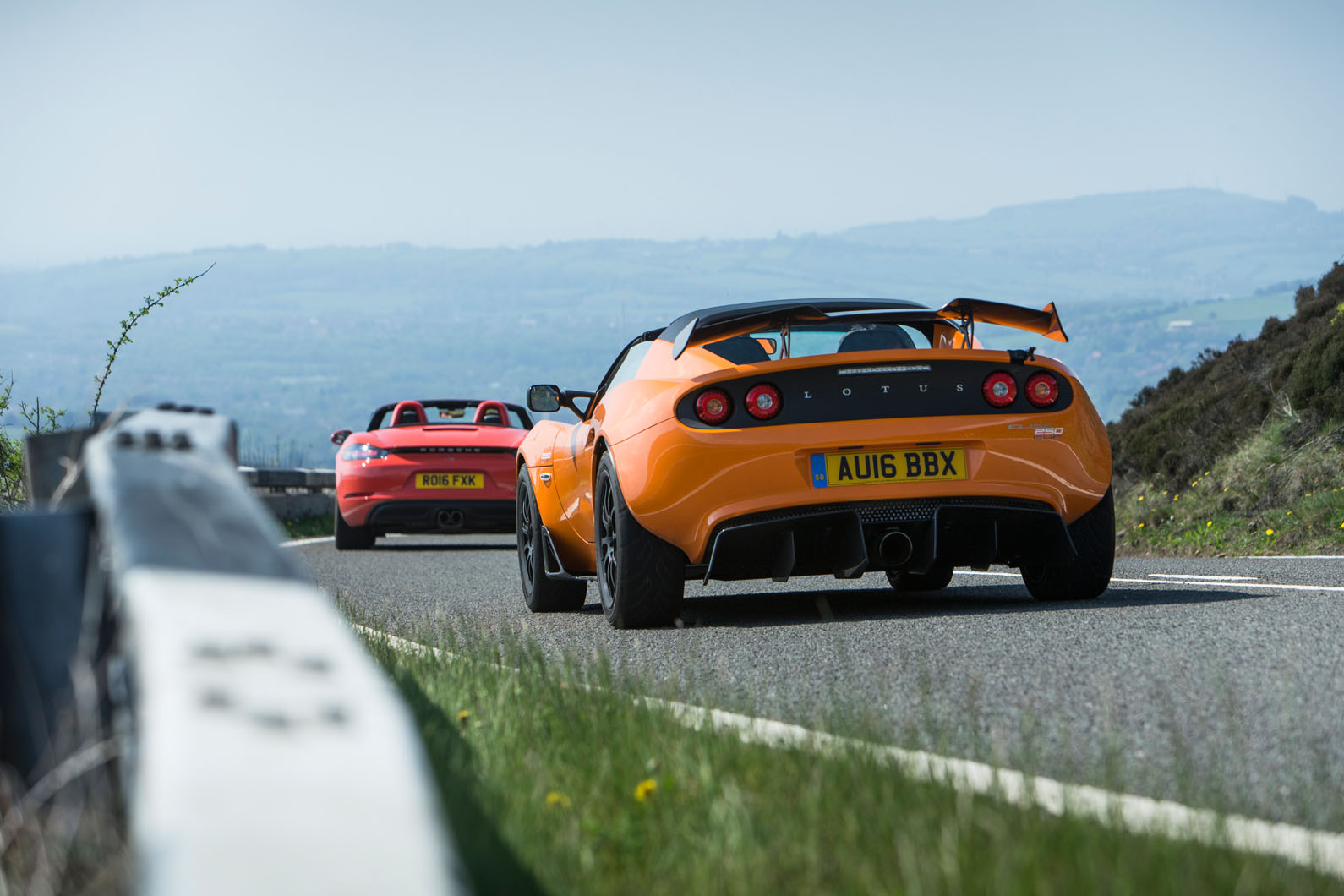
Showiness, though, is a secondary advantage. The accoutrements – all in carbonfibre, thanks to a £4k option pack – are there to deliver 66kg of downforce at 100mph. That level of track-spirited seriousness is reflected inside, where the Cup is even more spartan than normal, merrily doing away with even the stereo and introducing carbonfibrebacked seats that are reportedly 6kg lighter than the standard brace.
As ever, the act of getting into them with the roof on automatically eliminates anyone with back or knee trouble, due to the Elise’s scurrilously big sills and low floor. Have a chum next to you and it’s a squeeze. Take the chum out and it’s still a squeeze, because one knee props against the transmission tunnel and the other against the door. The thin race seats started to hurt my back after about three minutes. The start-up procedure, which still involves a cantankerous immobiliser, hurt my brain after about 10 seconds.
Discomfort is not something the 718 tolerates. Its seats are featherbeds in comparison, its footwells as wide as the Humber and the trim quality as distant from the Elise as I imagine Kensington Palace is from the inside of a Weatherspoons. It is the kind of ‘quality’ experience we’ve come to expect from Porsche, undiminished by its absorption into the VW Group and enhanced (now) by the fitment of the manufacturer’s latest infotainment system. A steely-eyed enthusiast might point out that the soft-touch interior is merely another unwanted layer of artifice between your underside and the road surface, and the Elise’s exposed aluminium chassis is a reminder of the purity of the experience that’s being imparted. Fair enough, but it’s nearly impossible to become fatigued in the Boxster, and when you want, there’s a button to make the roof disappear.
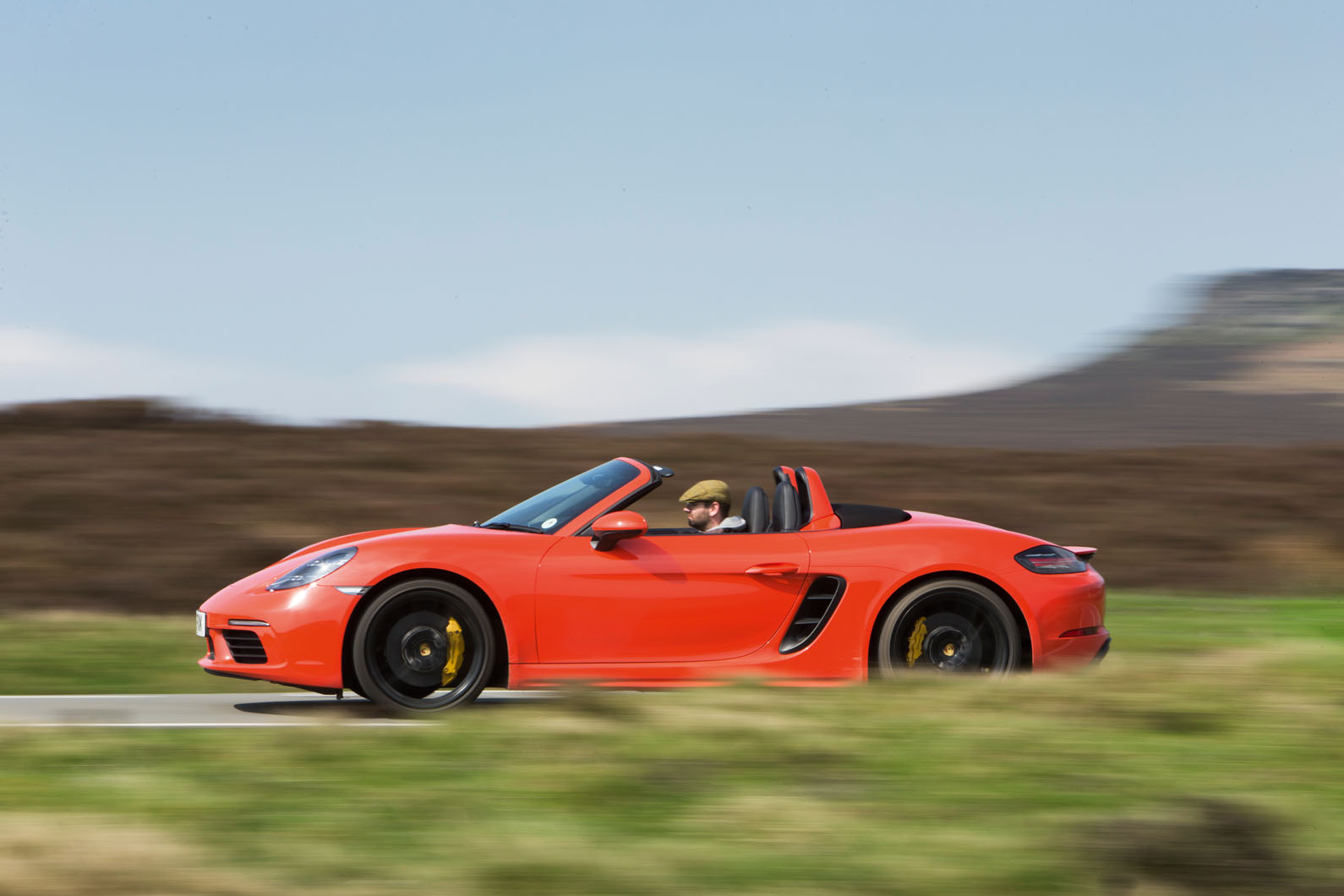
This it does as smoothly and as crisply as everything else, and in a way that suggests it doesn’t weigh the moon. The Cup’s roof, of course, is light enough for a toddler to pick up – but it’s also still a by-the-roadside faff, still involving levers, struts and scroll-style rolling up. It’s a reminder that the Elise’s relationship with the idea of everyday, all-weather use is somewhat tenuous – an opinion hardly undone by its reported failure to stay completely watertight in the torrential rain experienced on our way to the Peak District.
The setting for back-to-back driving is the Snake Pass, a winding strip of A-road clinging to the north fringe of the Peak District. It’s infamous for the toll it takes on the lives and limbs of bikers – the reason why its speed limit is not national. Instead, it’s set at 50mph, an artificial ceiling its commuters treat with utter contempt, as they do double white lines, caravan drivers and magazine photographers.
When we arrive, early in the morning, it is as misty as untreated glaucoma and saturated in what must have been week-long rain. In earshot of the road, there’s enough water babbling past to cool a plutonium rod thicket. However, you can’t hear it in the Boxster, which, one suspects, would need to see the bottom of a lake before its hood became permeable. Expertly, its cloth lamina subjects its occupants to little wind or road noise while making the engine note ever present. Which is where we arrive at the nail in the 718’s boot.
There’s no need to drive the Boxster to know that it has suffered diminishment. The previous flat six coughed and chugged into life like an East End landlord and then rasped and howled free-throatedly in the same vein if you prodded it. The four-pot boxer is the Eastenders version of the same character: timid and two-dimensional in its imitation and without the ferocity. The exhaust note is as carefully engineered as a titanium protractor but is made tightbodied by the turbo and, despite the bass in the mid-range, sounds more generator-thrummy than gravelly.
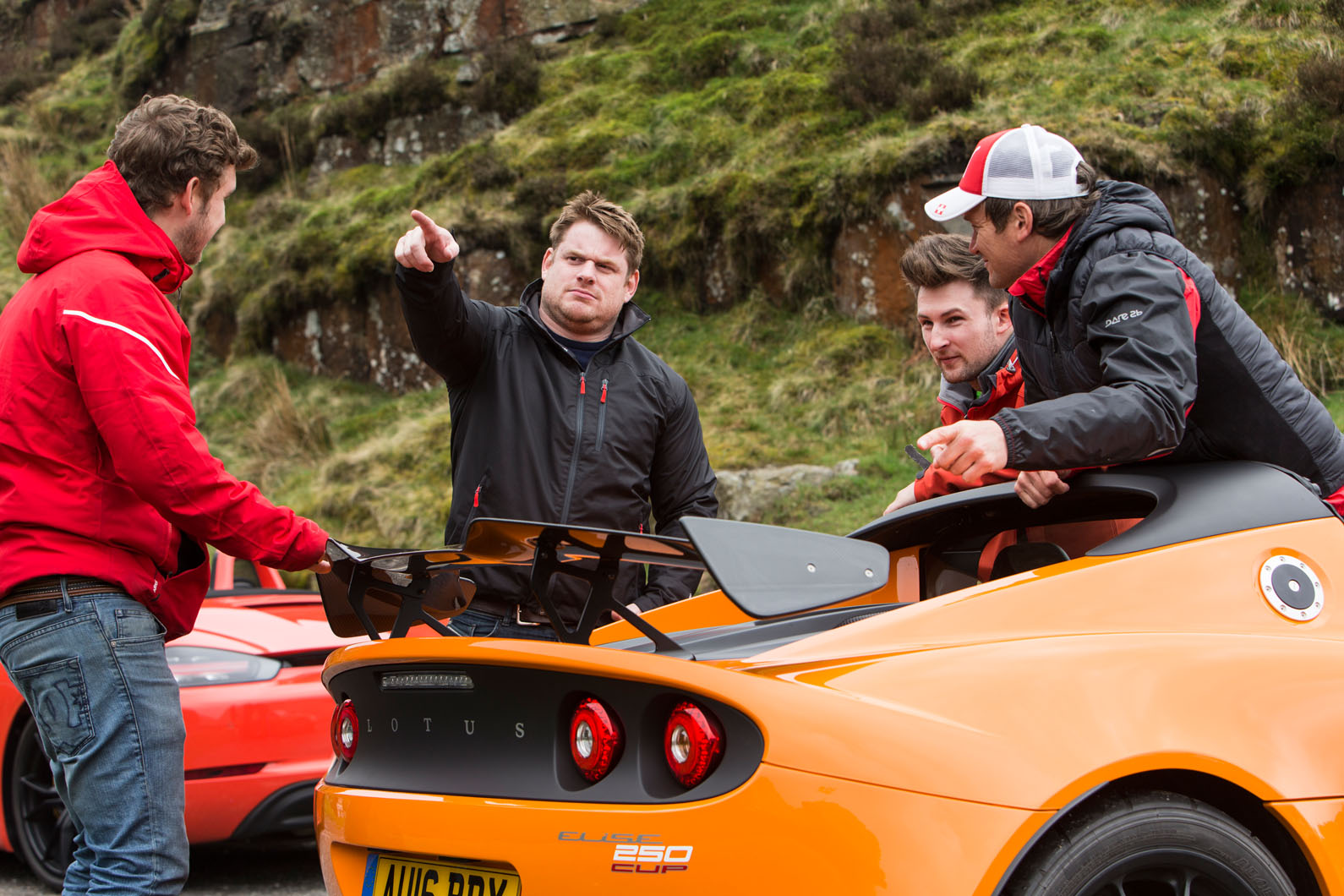
It’s worth stating early that none of this prevents the 2.5-litre engine from being world class. Had it been sprinkled into a VW Golf R, we’d be wetting ourselves. On the road, above very low crank speeds (but well before the flat six woke up) it’s hugely responsive, eager to rev and receptive to being wound into the 1000rpm between peak power and the limiter.
There’s no ignoring the elephant in the engine bay, though. As acutely biddable as it may be, the unit is a backwards step in terms of charisma. The flat six revved for no longer, but the final throes of its ratios seemed all about metallic fury and empowerment and whisking the troposphere into dopamine. Thwacking the redline was mechanically essential and unmissable – not the clamorous end result of an ECU’s algorithm.
The Lotus highlights this by having its more modest-sized engine doing many of the same things well and some of them better. Hethel has tweaked and tuned and tousled the humble heartbeat of the Toyota motor to fine effect, engendering a frothy, raspy little engine – one that, thanks to the supercharger, doesn’t suffer the 2500rpm torque-induced neck snap of the Porsche or the lag beneath it and hard charges more progressively (but no less enthusiastically) towards a brick-wall limiter.
Its deficiency is in muscle mass. Shy of 4000rpm in the wrong gear, it’ll prevaricate, whereas the 718 has 310ft lb of ballast to underpin its longish ratios. The Cup’s weight advantage can’t make up the gap to a modest 184lb ft, and it’s unaided by its plodding gearchanges.
Lotus claims it’ll do 3.9sec to the national limit denied the Snake Pass – and perhaps it will – but, real world, it often doesn’t feel like the straightline equal of the 718. Porsche, for its part, says the new S will lap a circuit as quickly as the outgoing Spyder. That’s a bold claim. The last Boxster I drove was the Spyder. I think I made it my car of the year. If I didn’t, I seriously considered it. That car was miraculous; this one isn’t. What it is, right out of the box, is enormously comfortable, cannily direct and as easy to get along with as a pair of cashmere-lined slippers.
Alterations to the chassis – not to mention the £1133 adaptive PASM dampers – have made the 718 astonishingly compliant. In most circumstances short of flat out, it feels as much like a grand tourer as a sports car. It strikes catseyes, even on 20in wheels, with extraordinary compassion. Any venom usually transmitted up through the suspension towers by the Snake Pass is nullified well before it hits a seat, and if the Boxster ever bridles at the absence of a fixed roof, I never felt it.
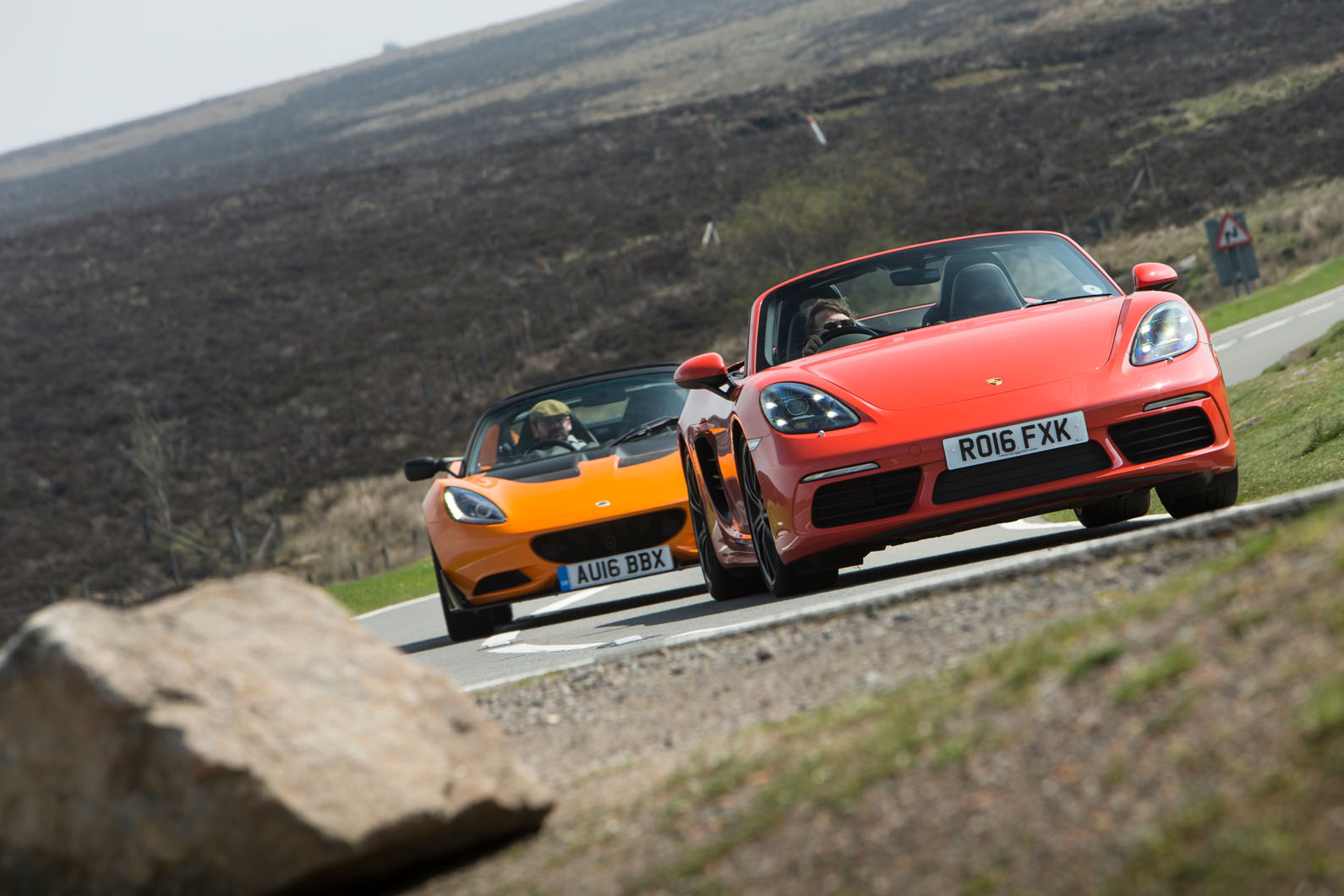
The Elise is a kicked beer can in comparison. It was ever thus and, truthfully, many will be thrilled that it is. None of the model’s immediacy or handling pungency has been misplaced in the overhaul. The Cup tumbles down the road in much the same way as it ever did: hollowsounding, alive to input and with the adhesive qualities of solder. Or when the road surface dries out, at any rate. Early on, the track-addled Yokohama A048s did not take kindly to the idea of moving water aside and aquaplaned like a seagull’s feet.
This is a distant memory on the wind-cleaned Snake Pass, though. To help you in a pit lane to dial out the Elise’s preference for understeer, the Cup gets an adjustable anti-roll bar and wider tyres at the front – but on the road, its default traction is unwavering despite the extra power. The car has moments – aboard nicely cambered corners – where it feels suckered to the road in a way that eludes car twice its price and payload.
That it still feels animated and effervescent while it does this is, of course, Lotus’s secret. There’s no putty-like softness to the Elise, just the kind of sublime, sympathetic wheel control you can summon up with Bilstein gas dampers, Eibach coil springs and an extruded bonded aluminium chassis to mount them on. The unassisted steering, like listening to vinyl after a decade of MP3s, is still a revelation: brittle, stubborn, inconvenient, palmwearing – and staunchly brilliant.
The 718 can’t replicate the authenticity of its escalating heft and doesn’t even try. Instead, it gives us the electric-powered modern-day equivalent: a wonderfully weighted, stictionless rack that serves up in damping, directness and ease of use what it cannot deliver in feedback. It’s reputedly 10% sharper than before, but there’s no ramped-up positivity to the Boxster’s change of direction. It feels terrifically well balanced, with the same mid-engined tendency to push on in an overcooked corner as the Elise and with the same tolerance for a communicative dip of the body. The difference is that the 718’s back axle, garnished with Porsche’s £890 locking rear differential and torque vectoring, is more explicitly wired to the throttle and bristles suggestively with implied yaw. The Cup is no less talkative but, at road speeds on stickier tyres, it stays as true to its line as an amber rocket sled.
That attitude is unsurprising in an Elise more attuned to the demands of circuit driving. The fact that it doesn’t compromise the Cup as a road car speaks to the deft talent of Lotus’s engineers. Nevertheless, ownership does require compromises of you – and this range-topper is an expensive item to keep in a box marked ‘when in the mood’ – especially when its billing as the fastest Elise yet doesn’t necessarily stipulate any greater level of road-going enjoyment than the lighter, less powerful starter model.
The 718 Boxster suffers no such pigeonholing. If anything, the broad appeal of the previous model has been widened further still to include the contentedness that results from an enhanced interior, sleeker rolling refinement and superior chassis. The car complements any frame of mind you bring into it, as it continues to flatter any road and every level of driver-applied interest.
Only its ability to act as a mood changer can be seriously questioned. There’s no cast-iron guarantee now that the frown will turn upside down, or that any of the rest of your face will go unconsciously post-coital. In that respect, what the Boxster has lost can not be easily replaced – not by greater usability, or by cheaper running costs, or even by greater speed. Rest assured, Porsche won’t stop until normal specialness is resumed – but, for now, the 718 goes top of our list again with an unfamiliar proviso: good but not great.
Porsche 718 Boxster S:
Rating 4/5 Stars; Price £50,695; 0-62mph 4.6sec; Top Speed 177mph; Economy 34.9mpg (combined); CO2 emissions 184g/km; Kerb weight 1355kg; Engine layout 4 cyls, 2497cc, turbo, petrol; Power 345bhp at 6500rpm; Torque 310lb ft at 1900rpm
Lotus Elise Cup 250:
Rating 4/5 Stars; Price £45,600; 0-62mph 4.3mph; Top Speed 154mph; Economy 37.7mpg (combined); CO2 emissions 175g/km Kerb weight 921kg Engine layout 4 cyls, 1798cc, supercharged, petrol; Power 243bhp at 7200rpm; Torque 184lb ft at 3500rpm





































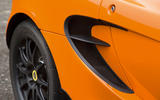



Join the debate
Add your comment
Exige roadster would have been a better choice
If you did consider a Lotus as an alternative my guess is that you'd look at an Exige. It would still wear you out but if you're considering the Lotus you're probably looking for something fun for the weekend & I'd argue that that would be less on an issue.
One car can be used every day.....
You could use ANY car every day if you wanted to enough and although the roof may be a bit more fiddly on the Elise and the interior a bit less plush, I'd pick it over the Boxter every time.
I don't think that makes me a C*#t, does it?
What the hell does "palmwearing" mean when describing a car?